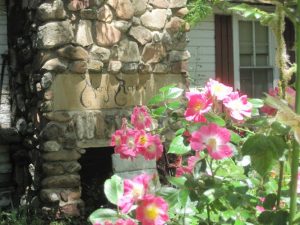You are viewing ARCHIVED content. Please note that this content is no longer updated and links may not work.

Allen Park Adaptive Reuse and Management Plan
— Quick Links —
Project Description
Preparing an Adaptive Reuse and Management Plan for Allen Park was prioritized in the Department’s Reimagine Nature Public Lands Master Plan. A General Obligation Bond to fund parts of the master plan was approved by voters in 2022, with $4.5 million identified for Allen Park improvements.
With public support, the City desires Allen Park to be an open, public pedestrian park that highlights the site’s unique history, preserves and enhances ecological features, repairs the artistic expressions scattered throughout the site, and restores the main house and other structures.
To reach this goal, Salt Lake City Public Lands has followed recommendations from the Allen Park Cultural Landscape Report and collected public input through online and in-person opportunities to determine the preferred uses for the site.
Project Details
Project Location
1328 Allen Park Dr, Salt Lake City, UT 84105
Project Manager
Kat Andra
katherine.andra@slc.gov
Project Status
Finalizing Plan
Project Updates
Final Concept Reveal
The final draft of the Allen Park Adaptive Reuse & Management Plan was finalized by the Department of Public Lands.
The final plan concept, “Arts & Sciences in the Wild” provides opportunities for education and passive recreation while revitalizing the stream corridor and repairing key historically significant structures on the property.
Next steps include beginning management of the site in accordance with the approved Adaptive Reuse and Management Plan. In 2025, Public Lands will select a design consultant to begin detailed design for Phase I of improvements, outlined in the final plan. The budget for Phase I Design and Construction is $5 million from the voter-approved GO Bond, and internal City funds for improvements to Emigration Creek.

Community Engagement
Engagement Background
In the summer of 2023, Salt Lake City Public Lands, with the assistance of consultants at Wilkinson Ferrari & Co. and GSBS Consulting, embarked on a year-long public engagement process to seek input on future uses for Allen Park. The planning team engaged the public through a variety of in-person and online engagement opportunities that were promoted throughout the city.
The goals for the public engagement process were to:
- Build awareness of the Adaptive Reuse and Management planning process.
- Understand community priorities and desires for Allen Park’s future.
- Solicit input from diverse audiences throughout the city.
First Round of Public Input & Results
This phase of public input was held between June – September 2023 and involved collecting ideas and feedback from the public to help shape potential concepts for the future of Allen Park. Community members were invited to attend an open house or/and complete an online survey to provide feedback on the concept designs. Information about the project and how members could get involved was shared through multiple channels.
The link below is a summary of community engagement activities held at this visioning phase and the findings.
Project Timeline

Preliminary planning and research

Technical evaluations with consultants and experts

Phase 1 of Engagement: Identify community values and vision for the park

Phase 2 of Engagement: Develop concept plans and seek community feedback

Review community feedback and develop final adaptive reuse plan

Finalize Adaptive Reuse and Management Plan
Frequently Asked Questions
Where is Allen Park, and what is being done there?
Located just east of Westminster College in the Sugar House district of Salt Lake City, Allen Park is a nearly eight-acre parcel – the eclectic former home and estate of the Allen family – that stretches along a quarter mile of Emigration Creek. With support from community members and organizations, the City bought the culturally and environmentally important site in early 2020 with the intent to create a public park.
Determining how best to adapt the property into a public park is the next step in the process. Creating an Adaptive Reuse and Management Plan for Allen Park was prioritized in the City’s Public Lands Master Plan, Reimagine Nature, adopted in 2021. A General Obligation Bond to fund parts of the Citywide public lands master plan was approved by voters in 2022, with $4.5 million identified for Allen Park improvements.
With public support, the City desires Allen Park to be an open, public pedestrian park that highlights the site’s unique history, preserves and enhances ecological features, repairs and celebrates the artistic expressions scattered throughout the site, and retains the most culturally significant structures on the site.
To reach this goal, Salt Lake City Public Lands is following recommendations in the Allen Park Cultural Landscape Report (CLR), completed in 2022, and seeking public input through robust online and in-person public engagement throughout summer and fall 2023 to determine preferred uses for the site.
Why is Allen Park worth saving?
Allen Park is a treasured, one-of-a-kind, culturally rich, and environmentally important landscape along the banks of Emigration Creek. One of the last remaining largely undeveloped parcels in the Sugar House area, Salt Lake City acquired Allen Park in March 2020 to prevent its development and create a publicly accessible park. The City’s reasons for purchasing the property include the following:
- Save one of the large parcels of open space left on the east side of the City;
- Preserve important City history and Allen Park as a cultural resource;
- Protect and enhance the Emigration Creek riparian corridor;
- Improve the creek’s floodplain to better control water flow;
- Preserve the potential to connect trails through Allen Park; and
- Create a new park with active community use.
Allen Park was created by Dr. George Allen, his wife, Ruth Allen, their family members, and local folk artists, largely between 1931, when the Allens moved to the site and Dr. Allen’s death in 1961. Dr. Allen was also known for his eclectic interests, ranging from creating mosaic poetry to collecting and caring for exotic birds. He helped launch Salt Lake City’s Hogle Zoo and Tracy Aviary. Allen family members and renters in the property’s duplexes continued living at Allen Park until 2018, when the land was sold for development. Salt Lake City then bought the property in 2020 with the intent of creating a public park. The cultural importance of Allen Park is documented in the Cultural Landscape Report (CLR), published in 2022.
What decisions about Allen Park have been made so far?
The biggest change is that the Allen Park property is now in public ownership as a park cared for by the City’s Public Lands Department. The City opened Allen Park to public access in October 2020, and it is subject to the same rules that apply to all parks by ordinance. A security guard is posted at the Park’s entrance as a temporary measure, given the danger of numerous dilapidated buildings and the need to protect the unique artworks.
The City is now in the process of developing the Allen Park Adaptive Reuse and Management Plan, which will determine future decisions made in the park based on public engagement and the findings of the Allen Park Cultural Landscape Report (CLR), which documents the site’s history and cultural importance. Until the Adaptive Reuse and Management Plan is completed, the City will use the CLR to guide management and operations at the Park.
What we know for sure is that the park will remain open as a public pedestrian park that celebrates the unique ecology and Emigration Creek that runs through the park. Recommendations for future programming and capital improvements to the site and structures will be made in the Adaptive Reuse and Management Plan. As part of the Parks, Trails, and Open Space General Obligation Bond approved by City voters in November 2022, $4.5 million is allocated for improvements at Allen Park. We are currently gathering public input for the future of the site and would love your thoughts! Visit our community engagement page here to participate.
Some of the structures are falling down. What is going to happen to the Allen House and other buildings?
Allen Park’s houses and other buildings are in generally poor condition and are fenced off from public access for safety reasons. Technical and cultural assessments, along with public input conducted as part of the Adaptive Reuse and Management Plan process, will help determine if and how the Park’s buildings can be renovated and used. The future of each structure will be based on its physical condition and ability to be repaired, its cultural contribution, the financial investment required, the public’s priorities, and the programming identified for the site.
The reuse and management planning process continues through the end of 2023, after which the plan will be considered for implementation by the Mayor and City Council. In the meantime, urgent property repairs may occur to high-priority structures such as the main Allen Lodge, and the others will remain in place if they do not pose a safety risk to park visitors. A damaged wooden bridge across Emigration Creek was removed in May 2023 by flood-control crews to prevent it from collapsing into the high water and damming the stream.
What is going on with the maintenance of Allen park while the City is making improvements?
When the City acquired Allen Park in 2020, Public Lands requested funding to maintain the site as it existed. Without a plan for the future of the landscaping and/or structures, the City did not want to spend money on assets that would not persist into the future. As we begin detailed design of the improvements outlined in this site plan, Public Lands will request a full maintenance budget for all the proposed elements as the come online within the park.
In addition, there is limited infrastructure on the site for irrigation and other utilities to support regular maintenance. Public Lands is working on projects currently to install the necessary infrastructure to improve maintenance.
Will the artwork be saved?
The Adaptive Reuse and Management plan recommends saving and rehabilitating all of the artwork on the property. Artwork will be retained in place to the greatest extent possible, but some may be required to be moved in order to preserve as well as possible. Currently, there is some funding in-hand to begin rehabilitation, so Public Lands will begin with works in the most critical condition.
What is going to happen with the fencing?
It is the City’s goal to ultimately remove all of the black chain link fence, and open up as many landscaped areas as possible to the public, including the meadow, landscaping surrounding some of the structures, and larger gathering areas that will replace structures slated for removal. Fencing may be required to secure structures and prevent access, but the current chain link will be removed and replaced with something more appropriate for the site, in accordance with the Cultural Landscape Report. It is likely the entry gate will remain for safety reasons due to structures remaining on-site.
What will happen to the peacocks?
The Friends of Allen Park, one of the City’s recognized community organizations, has been stewarding and caring for the peafowl in Allen Park since the City acquired the property in 2020. While not a native species, peafowl have lived at Allen Park for decades. Throughout the planning process for the Adaptive Reuse and Management Plan, the planning team has assessed and will recommend potential management strategies for the peafowl and wildlife within the park. This will include researching and identifying best practices for managing peafowl in the context of other wildlife and park visitors. The peafowl and other wildlife are unique features of the park and were considered throughout the public engagement and planning processes, and in the final design.
How was the number of parking stalls determined?
Parking was recommended in the final plan based on a few factors:
- The size of events and gatherings desired by the community, which is small. Generally, the spaces that will be designed will accommodate gatherings of 15-20 people
- The size of available space within the park
- The parking that would be needed, after a parking assessment, for regular park use. Parking for special events will be considered elsewhere on a case by case basis
- Accessible stalls were included at the rate required with the current parking ratio to meet ADA requirements.
Will dogs ever be allowed in Allen Park?
Dogs are not allowed in Allen Park and that won’t change during the current planning process. Identifying the site’s needs and balancing varied public interests is part of the Adaptive Reuse and Management Plan process. The final Plan will outline appropriate strategies to support the recommended future use and activities in the Park. The decision to allow dogs or not in the park is a policy decision and made outside of this planning process, but for now, dogs will continue to be prohibited at the park.
Will bikes be allowed to ride through the park?
The planning team will include in the final plan recommendations for bikes and pedestrians within the park. There are many considerations that go into this decision, including the wildlife and habitat within the park, user experience, and the potential for the regional trail connection through the park. While this park will be a key connector in the City’s east-west trail connections, bikes will not be prohibited at the park. However, recognizing the unique concentration of wildlife and habitat at this park, measures will be required and recommended to mitigate conflicts.
How will improvements be paid for?
The Adaptive Reuse and Management Plan will make recommendations for potential capital improvements and future programming at Allen Park. Thanks to voter support of the $85 million Citywide Parks, Trails, and Open Space General Obligation Bond approved in November 2022, $4.5 million is available for capital improvements at Allen Park. The current planning and public engagement process will result in recommendations for improvements to be made with this funding. It is likely that $4.5 million will not be adequate to complete all recommended improvements to the park, so the Adaptive Reuse and Management Plan will also outline strategies for future funding.
Public Lands is also working with other internal and external stakeholders to pursue funding to continue to fulfill the full vision for the park.
What is the timeline for construction and how will it affect access to the park?
Once the plan has been finalized and all comments have been received, anticipated early 2024, the City will go through our bidding process to get a landscape architecture consultant on board to design the $4.5 million worth of bond projects recommended in the plan. Generally, design is anticipated to take about a year with construction to follow. Significant improvements in the park can be expected for 2025-2026, and may impact access to the park.
Additionally, the City will be working on short-term maintenance projects in the meantime, including adding water lines to the park for landscaping and fire suppression, beginning in early 2024, structural improvements to high-priority structures, and repairs and improvements to the art on-site, as well as other smaller projects as necessary. Public Lands will alert the public with any closures or impacts to accessing the park, so keep an eye on our social media or sign up for our newsletter on our website.
Are there other opportunities to provide input?
Public Lands will collect comments through January 8th. Please visit allenparkslc.org to view the final concept draft and leave comments.
Additional Resources
Full Adaptive Reuse and Management Plan
Lee el documento completo en español
Read the full Adaptive Reuse and Management Plan, available in English and Spanish.
Print and share a fact sheet about Allen Park and the Adaptive Reuse and Management Plan.
Existing Conditions Report
Update to existing conditions analysis including a summary of existing reports, structural and seismic evaluation of all buildings, and an inventory and evaluation of landscape and art elements.
Public comments and ideas for Allen park shared in Spring 2020.
This handbook and the related maps represent options for the future of Allen Park.
Describes Allen Park’s cultural history and significance. A principal source for integrating the cultural landscape with long-term park goals.
Video from the virtual open house held on December 11, 2023. A written transcript can be found here.